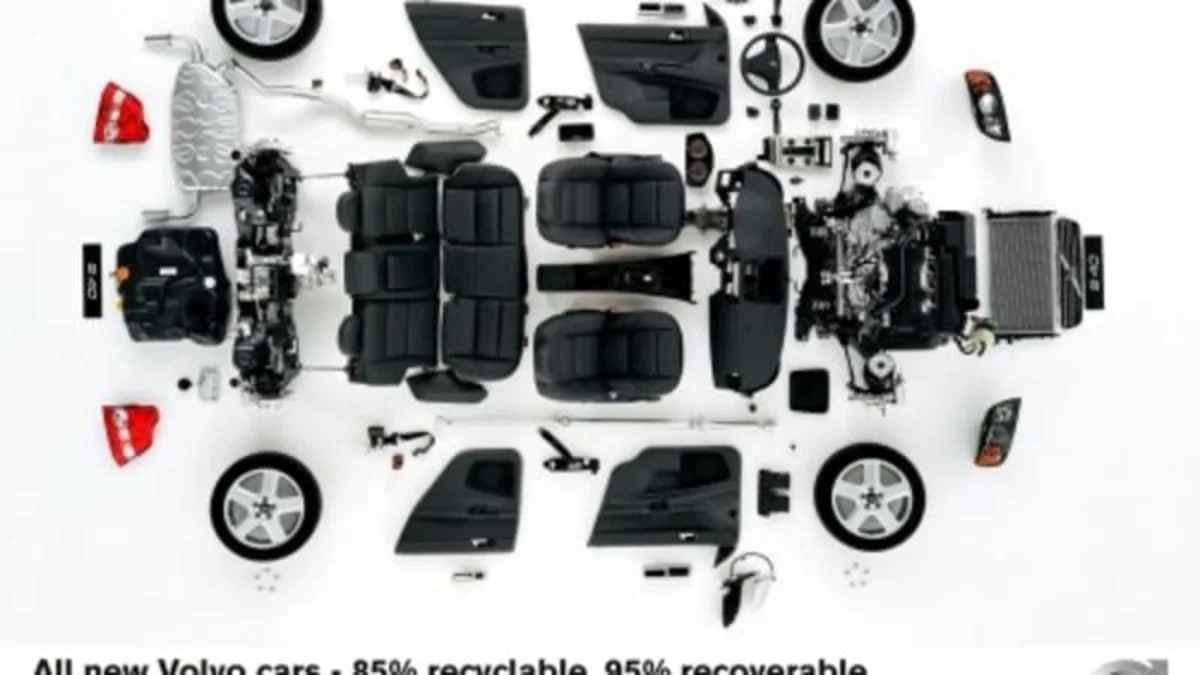Click on the image to enlarge
While safety is likely the first thing that springs to mind when the automotive conversation turns to Volvo, the Swedish auto manufacturer would like the average person to know about its efforts to reduce its impact on the environment. To that end, Volvo has launched its 'Clean inside and out' program, which outlines everything that the automaker is trying to do in protection of the environment.
After the break, we've pasted Volvo's latest press release detailing some of its environmental policies, but one figure stands out in our minds: all new Volvo's are 85 percent recyclable and 95 percent recoverable and have been so since 2002. In an age where cars are often looked as necessary but disposable objects, we can respect the distances that Volvo is going to address their environmental impact.
While safety is likely the first thing that springs to mind when the automotive conversation turns to Volvo, the Swedish auto manufacturer would like the average person to know about its efforts to reduce its impact on the environment. To that end, Volvo has launched its 'Clean inside and out' program, which outlines everything that the automaker is trying to do in protection of the environment.
After the break, we've pasted Volvo's latest press release detailing some of its environmental policies, but one figure stands out in our minds: all new Volvo's are 85 percent recyclable and 95 percent recoverable and have been so since 2002. In an age where cars are often looked as necessary but disposable objects, we can respect the distances that Volvo is going to address their environmental impact.
Press Release:
VOLVO – CLEAN ALL ITS LIFE
* All new Volvos are 85% recyclable and 95% recoverable
* Climate neutral manufacturing
* Material and parts selected for low environmental impact
* Customer carbon footprint data by model
Volvo Cars' commitment to environmental activities and continuous investment to help reduce its carbon footprint goes far beyond lowering CO2 emissions. Volvo's 'Clean inside and out' programme represents a holistic approach to the environmental impact of the car. It focuses on health, resource utilisation and the ecological consequences of the production, use and disposal of the vehicle.
Recycle, Re-use
A recent European Commission study stated that all new vehicles should be at least 85% recyclable or reusable by 2015. All new Volvo cars reached this figure in 2002. Volvo ensures all new models are 85% recyclable and designed for 95% recoverability as well as introducing initiatives to ensure that vehicles are clean throughout their life. The use of recycled materials such as steel, iron, aluminium and many other metals is common practice, while metals from the catalytic convertor are reused in new catalysts. Even the Volvo battery plastic covers become the wheel-arch liners on new cars.
Climate neutral manufacturing
Volvo Cars' focus on other energy sources than oil has been going on for more than 25 years. Back in 1982 the company took the first step by using residual heat from the nearby refineries to heat the factory in Torslanda, Sweden. In 1988 Volvo started using natural gas, which was the main fuel for heating its European factories (Sweden and Belgium) and, from 1 January 2008, Volvo's European manufacturing units now only use green electricity – hydropower. This is Volvo's latest step in making its production climate neutral and future plans may also extend to other energy sources such as biogas and wind-power.
Material selection
Volvo continues its dedication to customer care by removing harmful materials traditionally associated with automotive production from its manufacturing processes. All traces of lead, cadmium, mercury and chromium can no longer be found in a Volvo, even the tanning procedure to create the leather in the seats has been changed to avoid the use of chromium. The interior of all new Volvos has been designed to comply with a strict international standard called Oeko-Tex, which ensures that all the materials used are hypoallergenic and free from hazardous substances.
Recycle parts and exchange
In addition to responsible manufacturing, servicing is also an environmentally friendly activity. Volvo has created the Volvo Exchange System where used parts are collected from dealers and remanufactured to the same quality as new parts. The Volvo Exchange System offers reconditioned, guaranteed, Volvo approved parts, ranging from starter motors to whole engines.
Assess Volvo's wholelife impact
Volvo provides environmental information to customers, in the form of the Volvo EPI (Environmental Product Information) for all of its models, split by engine and transmission. This covers the car's environmental impact during production, use and disposal; enabling the environmental impact of any Volvo model to be judged independently. It gives an integrated picture of the car's total environmental impact and makes it easier to assess and compare between different Volvo models and engine options. For more information visit the Lifecycle diagram section at www.volvocars.com/epi
[Source: Volvo]


Sign in to post
Please sign in to leave a comment.
Continue